Maersk has announced that TradeLens, the joint blockchain initiative for international shipping with IBM is closing. Launched in 2018, many believed that Maersk would not be able to attract other container shipping firms, but MSC and CMA-CGM joined in 2019.
“TradeLens has not reached the level of commercial viability necessary to continue work and meet the financial expectations as an independent business,” said Rotem Hershko Head of Business Platforms at A.P. Moller – Maersk.
“Unfortunately, while we successfully developed a viable platform, the need for full global industry collaboration has not been achieved.”
While TradeLens signed numerous shippers and hundreds of ports, carriers and customs clearance organizations, that doesn’t mean they all used it extensively. For example, last year MSC launched its own electronic bill of lading (eBL) offering, partnering with blockchain startup WaveBL, which appears to have been very successful.
TradeLens was one of the first big supply chain blockchain initiatives. But other early enterprise blockchain initiatives have also shuttered this year. They include another early IBM project, we.trade for trade finance and the B3i blockchain insurance consortium.
When TradeLens started, multiple industries envisioned creating large multi-functional blockchains for an entire industry. Now the belief is the need to develop interoperability between multiple blockchain infrastructures, which are often specialist, such as for bills of lading or trade finance.
There’s no shortage of other blockchain shipping initiatives. For example, in Asia, there’s Hong Kong-based GSBN, Japan’s TradeWaltz, and Thailand’s recently launched National Digital Trade Platform (NDTP).
TradeLens made numerous management changes in the last year. It hired a new CTO just over a year ago and CEO Kim Spalding joined eight months ago from Google. She replaced Mike White, the founding TradeLens leader and Maersk senior executive who retired earlier this year.
To date, the network processed almost 36 million documents and nearly 70 million containers. The network will go offline at the end of Q1 2023.
Why did TradeLens fail?
The cause of the TradeLens failure is being debated on LinkedIn. The two big issues that came up are the slow adoption of digitization in shipping and a lack of willingness to share data.
One of the clearest explanations was from Oswald Kuyler, who led the Digital Standards Initiative at the International Chamber of Commerce until earlier this year.
Currently, the digitization level in shipping is just two percent. For example, last year despite the pandemic, just 1.2% of bills of lading were digital.
“When the barriers are unlocked and that number goes up – I think more platform businesses will be sustained – each bringing slightly different benefits to different economic sectors based on requirements,” wrote Kuyler. “While trade itself is fairly consistent, the business cases across mining, retail, manufacturing etc, are different.”
When we first wrote about TradeLens five years ago, one of the industry comments we heard was that getting participants to share data takes a lot of work. One of the TradeLens participants reiterated that point to us today.
“Technology can only take you so far, especially in global trade where relationships and incentives are complex. Building trust among parties (esp. with governments), passing enabling policies and regulations such as MLETR all play crucial parts for success,” wrote Ziyang David Fan, who heads Digital Trade at the World Economic Forum.
He added, “The trend of trade digitization is non-reversible. We shouldn’t let small bumps in the road discourage all from trying.”
Andre Simha of the largest shipping firm MSC and chair of DCSA, observed, “It’s not a sign that digital trade is weakening. The journey to digital trade is tough, and we will likely see other attempts fail as well. The important thing is to… try again!”
Update: added section on Why did TradeLens fail?







